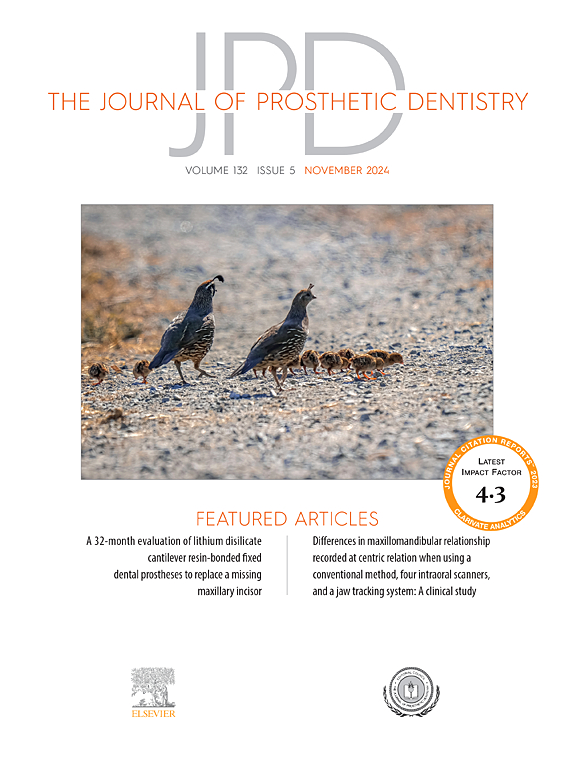Assessment of mechanical properties and microstructure of Co-Cr dental alloys manufactured by casting, milling, and 3D printing
IF 4.3
2区 医学
Q1 DENTISTRY, ORAL SURGERY & MEDICINE
引用次数: 0
Abstract
Statement of problem
The mechanical properties and microstructure of cobalt chromium (Co-Cr) alloys should be considered when choosing the best alloy for each clinical situation. More information is needed on the digital manufacturing methods of metals in dentistry, such as computer numerical control (CNC), and direct laser metal sintering (DMLS).
Purpose
The aim of this study was to investigate the effect of the 3 different Co-Cr manufacturing processes on the mechanical properties and microstructure of Co-Cr dental alloys.
Material and methods
Dumbbell-shaped specimens (n=6) were fabricated using casting (CAST), CNC, and DMLS techniques. Tensile, 3-point bend, and microhardness testing were performed, and the microstructure evaluated through scanning electron microscopy, energy dispersive X-ray analysis, and X-ray diffraction analysis. The ANOVA test followed by post hoc Tukey tests were used for statistical analysis (α=.05).
Results
DMLS showed the greatest values for 0.2% yield strength (908.0 ±13.1 MPa), tensile strength (1123.7 ±6.5 MPa), flexural strength (2273.0 ±43.2 MPa), and microhardness (438.2 ±44.9 HV), followed by CAST and CNC. No statistical differences were found for elongation between CNC and DMLS or DMLS and CAST (P>.05). No statistical differences were found in elastic modulus among all groups (P>.05). EDX revealed a slightly different chemical composition among the groups. XRD showed face-centered cubic as the dominant phase and a small amount of hexagonal close-packed structure in all groups. A peak of σ phase was identified in the CAST group.
Conclusions
The mechanical properties and microstructures of Co-Cr dental alloys were significantly influenced by the fabrication method used. DMLS and CNC milling produced better products that traditional methods, leading to the improved durability and reliability of dental prostheses. These advancements underscore the importance of selecting appropriate fabrication methods to optimize clinical outcomes and patient satisfaction.
通过铸造、铣削和3D打印制造的Co-Cr牙科合金的机械性能和微观结构评估。
问题说明:根据不同的临床情况选择最佳的合金时,应考虑钴铬合金的力学性能和微观结构。牙科金属的数字化制造方法需要更多的信息,如计算机数控(CNC)和直接激光金属烧结(DMLS)。目的:研究三种不同工艺对牙科用Co-Cr合金力学性能和显微组织的影响。材料和方法:采用铸造(CAST)、CNC和DMLS技术制作哑铃形标本(n=6)。进行了拉伸、三点弯曲和显微硬度测试,并通过扫描电子显微镜、能量色散x射线分析和x射线衍射分析评估了微观结构。采用方差分析和事后Tukey检验进行统计学分析(α= 0.05)。结果:DMLS在0.2%屈服强度(908.0±13.1 MPa)、抗拉强度(1123.7±6.5 MPa)、抗弯强度(2273.0±43.2 MPa)和显微硬度(438.2±44.9 HV)上最大,其次为CAST和CNC。CNC与DMLS或DMLS与CAST的伸长率无统计学差异(P < 0.05)。各组间弹性模量差异无统计学意义(P < 0.05)。EDX显示各组之间的化学成分略有不同。XRD结果表明,各基团均以面心立方相为主,且均存在少量的六方密排结构。CAST组出现σ相峰。结论:制备方法对钴铬牙科合金的力学性能和显微组织有显著影响。DMLS和CNC铣削生产出比传统方法更好的产品,从而提高了义齿的耐用性和可靠性。这些进步强调了选择合适的制造方法以优化临床结果和患者满意度的重要性。
本文章由计算机程序翻译,如有差异,请以英文原文为准。
求助全文
约1分钟内获得全文
求助全文
来源期刊

Journal of Prosthetic Dentistry
医学-牙科与口腔外科
CiteScore
7.00
自引率
13.00%
发文量
599
审稿时长
69 days
期刊介绍:
The Journal of Prosthetic Dentistry is the leading professional journal devoted exclusively to prosthetic and restorative dentistry. The Journal is the official publication for 24 leading U.S. international prosthodontic organizations. The monthly publication features timely, original peer-reviewed articles on the newest techniques, dental materials, and research findings. The Journal serves prosthodontists and dentists in advanced practice, and features color photos that illustrate many step-by-step procedures. The Journal of Prosthetic Dentistry is included in Index Medicus and CINAHL.
 求助内容:
求助内容: 应助结果提醒方式:
应助结果提醒方式:


